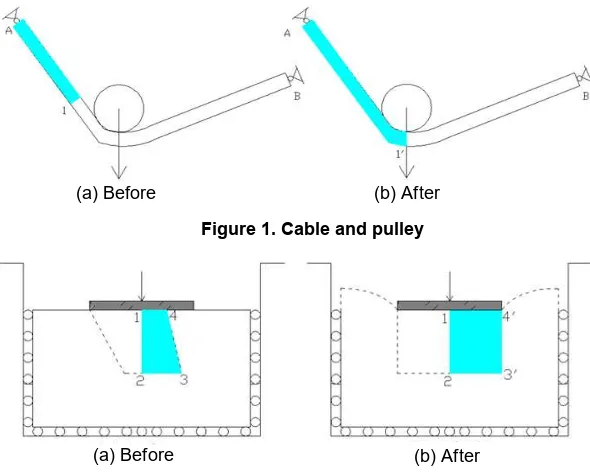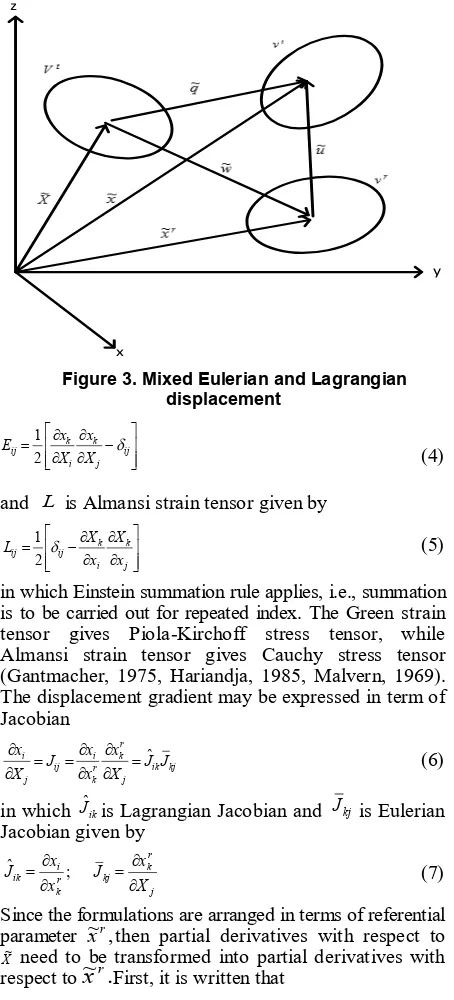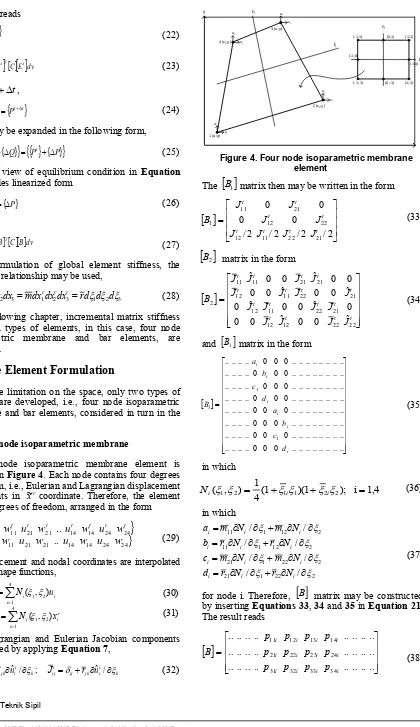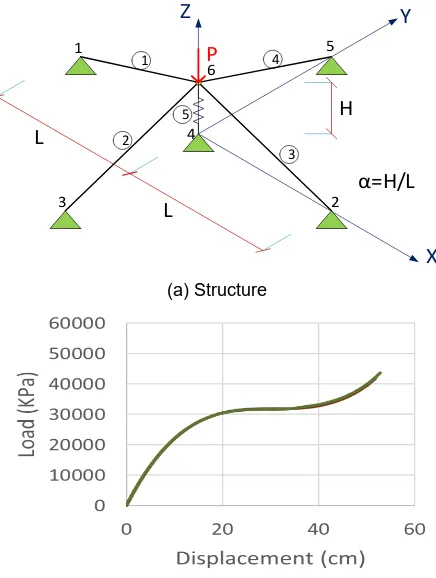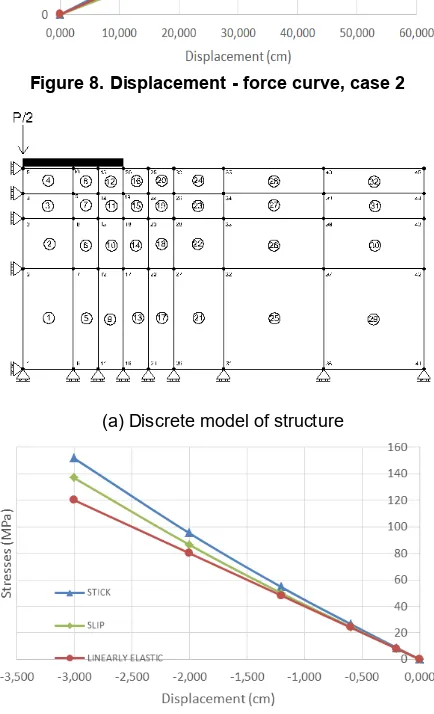The Use of Mixed Eulerian
-
Lagrangian Displacement in Geometrically
Nonlinear Analysis of Structural System
Binsar Hariandja
Civil Engineering Department, Bandung Institute of Technology
E-mail: [email protected]
Jurnal Teoretis dan Terapan Bidang Rekayasa Sipil Jurnal Teoretis dan Terapan Bidang Rekayasa Sipil
Abstract
The paper deals with the use of mixed Eulerian-Lagrangian displacement in geometrically nonlinear analysis of structural system, in which displacement and deformation are observed from a selected referential configuration, i.e., a configuration once occupied by the system along the loading process. The displacement measured from initial configuration into referential configuration is referred to as Eulerian displacement, and the displacement measured from referential configuration into current configuration is referred to as Lagrangian displacement. Geometrical nonlinearity of structure occurs when the displacement primarily consists of rigid body displacement, in which the choice in referential configuration is of great concern. The same deformation may be observed differently according to the choice in referential configuration. Analysis of continuum system is cast in finite element method and written in matrix formulation. The geometrical nonlinearity is approached by successive incremental steps in which the total loading is divided into several incremental loadings. The process is then linearized and incremental global stiffness matrix is used at every iteration step. The proposed mixed displacement is cast in a computer package program using Fortran language. The program is applied in several structural analysis, in which the conventional Lagrangian displacement may not be appropriate to model the analysis.
Keywords: Finitesimal displacement, geometrical nonlinearity, finite element method, successive incremental
loading steps.
Abstrak
Makalah membahas penerapan perpindahan campuran Euler-Lagrange dalam analisis nonlinier geometri sistem struktur, dalam mana perpindahan dan deformasi diamati dari konfigurasi referensi yang dipilih, yaitu konfigurasi yang pernah dilalui oleh sistem selama proses pembebanan. Perpindahan yang diukur dari konfigurasi awal ke konfigurasi referensi dinamakan perpindahan Euler, dan perpindahan yang diukur dari konfigurasi referensi ke konfigurasi akhir dinamakan perpindahan Lagrange. Nonlinieritas geometri sistem struktur terjadi dalam kasus di mana perpindahan terutama mencakup perpindahan badan kaku, dalam mana pemilihan konfigurasi referensi menjadi suatu langkah penting. Deformasi yang sama dapat diamati berlainan seturut dengan pilihan konfigurasi referensi. Analisis sitem kontinu didekati dengan langkah inkremental berturutan dalam mana beban total dibagi atas beberapa beban inkremental. Proses kemudian dilinierisasi dan matriks kekakuan global inkremental digunakan pada setiap langkah iterasi. Perpindahan campuran yang diusulkan dituangkan dalam program paket komputer yang dituliskan dalam bahasa Fortran. Program diterapkan dalam analisis beberapa sistem struktur, dalam mana perpindahan Lagrange konvensional tidak cukup untuk memodelkan perpindahan dalam analisis.
Kata – kata Kunci: Perpindahan finitesimal, nonlinier geometri, metoda elemen hingga, analisis inkremental
berturutan.
1. Introduction
In the analysis of solid structural systems, engineering mechanics is applied using a referential configuration from which displacement and deformation as well as reaction forces are observed. One may choose initial configuration as referential configuration; in this case, Lagrangian description is applied. Current configuration may also be chosen as referential configuration; in this case, Eulerian description is applied. Eulerian and Lagrangian descriptions are described in several references (Fung, 1965; Malvern, 1969).
In analysis of infinitesimal displacement, the choice of referential configuration is of no concern, since for this case, the two descriptions produce practically the same
results. But this is not the case in finitesimal displacement. The same displacement field produces different deformations if observed from initial or current configuration.
As an example, consider a prismatic bar with L = 100cm
in initial length. If the bar is stretched so as to obtain 101cm in final length, then the strain according to
Eulerian description becomes ɛ = (101-100)/101 =
0.0099, and according to Lagrangian description
becomes ɛ = (101-100)/101 = 0.0100, and the two
values are practically identical. But if the bar is stretched so as to obtain 150cm in final length, then the
strain according to Eulerian description becomes ɛ =
(150-100)/150 = 0.3333; and according to Lagrangian
description becomes ɛ = (150-100)/100 = 0.500. The
strain for the same deformation. This example clearly demonstrates that in case of finite displacement, it should be clearly stated from which both displacement and deformation are viewed.
2. Decomposition of Displacement Field
In addition to what has been described previously, it should be explained several additional informations. First, in Lagrangian approach, the material and the node (in finite element model) undergo the same displacement. Another words, the node and the pertaining material always be connected at all loading stages. However, one may be confronted with the problems that the node and pertaining material may undergo different displacement during loading progress. Example for this case, among others, are
steel raw material slipping into the mold in hot-rolled
process; cable slips around pulley; slip between interface of two bodies; and so forth.
Figure 1 depicts a structural system consisting a
pulley resting on a cable. The loading causess slip of pulley along the periphery of pulley, and then the cable and the pulley together undergo additional vertical and horizontal displacements. The slip between the pulley and the cable (point 1 and 1’) may be represented as Eulerian displacement, and the additional displacement as Lagrangian displacement.
As another example, Figure 2 depicts a structural
system consisting of soft layer resting on hard layer and a rigid bar is indented upon the soft layer. Loading in this case causes uniform vertical displacements in nodes on upper boundary of soft layer. If the interface between beam and soft layer is frictionless, there will
exist slip between the two bodies. Portion 1-2-3-4 of
soft layer will undergo to location 1-2-3’-4’. The
lower face of beam connects with different soft layer materials from time to time. This slip may be best modeled by
Through these examples, a necessity to decompose
displacement into Eulerian and Lagrangian components, arises. Generally, a configuration once
occupied by structural materials may be chosen as referential configuration. The decomposition of the displacement into Eulerian and Lagrangian portions is described in the following chapter.
3. Eulerian – Lagrangian Description
The decomposition of displacement is desribed by
showing displacement model in Figure 3. A typical
material point in the structural system at time t
occupies initial configuration at location . After loading, the material point eventually occupies current configuration at location A configuration, which may be occupied by structural system at a using Eulerian displacement.
particular time within loading process is chosen as referential configuration and denoted by The displacement of a typical material point initially occupied location at , is denoted by and this displacement decomposed into Eulerian displacement
and Lagrangian displacement
(1) Deformation may be observed by inspecting elongation experienced by a typical line segment that mapped into such that
(2)
following Euler description, and
(3)
according to Lagrange description. The entity is Green strain tensor given by
Figure 2. Rigid beam indented on soft layer Figure 1. Cable and pulley
(a) Before (b) After
(a) Before (b) After
t
V X~
.
~
x
t v
.
r
v q
~
X~
w~ u~,
w u X x x x X x
q r r ~ ~
) ~ ~ ( ) ~ ~ ( ~ ~
~
dS ,
ds
x d L x d dS
ds) ( ) 2 ~ ~ ( 2 2
X d E X d dS
ds) ( ) 2 ~ ~
( 2 2
(4)
and is Almansi strain tensor given by
(5)
in which Einstein summation rule applies, i.e., summation is to be carried out for repeated index. The Green strain
tensor gives Piola-Kirchoff stress tensor, while
Almansi strain tensor gives Cauchy stress tensor (Gantmacher, 1975, Hariandja, 1985, Malvern, 1969). The displacement gradient may be expressed in term of Jacobian
(6)
in which is Lagrangian Jacobian and is Eulerian Jacobian given by
(7) Since the formulations are arranged in terms of referential parameter then partial derivatives with respect to
need to be transformed into partial derivatives with respect to First, it is written that
(8)
which, upon inversion gives
(9)
in which is the element of inverted matrix of the matrix formed by Further, partial derivatives with respect to may be inverted to partial derivatives with respect to parametric coordinates by writing
(10)
which, upon inversion gives
(11)
in which is the element of inverted matrix of the matrix formed by Therefore, the following may be obtained,
(12)
4. Incrementation and Linearization Technique
It may be observed from the form of Equations 4 and 5
that the governing equilibrium equation is quadratic in terms of displacement components. Therefore, the problem would be geometrically nonlinear. The governing equilibrium equation may be expanded in terms of displacement components and the expression may be approximated by retaining linear terms. In this case, successive iteration scheme is applied.
The following is incrementation process of terms. First, at time the displacement is decomposed in Eulerian and Lagrangian displacement
(13)
Strain component is given by
(14)
For time displacement is given by
(15) in which is incremental displacement consisting Lagrangian incremental displacement and Eulerian incremental displacement . Correspondingly, total Jacobian components are incremented
(16) in which incremental Jacobian components are given by
(17) which may further be written in terms of Lagrangian and Eulerian incremental Jacobians. Strain components may also be incremented by writing
(18) which results in
(19)
Equation 19 may be written in matrix form
(20) in which is incremental displacement vector containing Eulerian and Lagrangian incremental displacements. Therefore, the following relationship is established.
(21) displacement
condition reads which may be expanded in the following form,
(25)
which, in view of equilibrium condition in Equation
22, provides linearized form
(26) where
(27) In the formulation of global element stiffness, the following relationship may be used,
(28) In the following chapter, incremental matrix stiffness of several types of elements, in this case, four node isoparametric membrane and bar elements, are developed.
5. Finite Element Formulation
Due to the limitation on the space, only two types of elements are developed, i.e., four node isoparametric membrane and bar elements, considered in turn in the following.
5.1 Four node isoparametric membrane
A four node isoparametric membrane element is
depicted in Figure 4. Each node contains four degrees
of freedom, i.e., Eulerian and Lagrangian displacement components in coordinate. Therefore, the element has 16 degrees of freedom, arranged in the form
(29)
and displacement and nodal coordinates are interpolated by using shape functions,
(30) (31)
First, Lagrangian and Eulerian Jacobian components
are obtained by applying Equation 7,
(32)
The matrix then may be written in the form
(33)
matrix in the form
(34)
and matrix in the form
(35)
in which
(36)
in which
(37)
for node i. Therefore, matrix may be constructed
by inserting Equations 33, 34 and 35 in Equation 21.
The result reads
(38)
in which
(39)
for node i. For flat plane membrane, stress-strain
relationship is controlled by constitutive equation
(40)
The obtained matrices may be inserted in Equation 27 to
construct element stiffness matrix. The element stiffness matrix is computed by using Gauss numerical integration technique.
5.2 Bar element
Bar element is depicted in Figure 5. The element has
two nodes and each node has two degrees of freedom arranged in the form
(41)
The displacement is found by interpolating nodal displacement vector with shape functions,
(42)
in which
(43)
and (44) and Jacobian components may be computed and used to construct element stiffness matrix. The result is
(45)
6. Case Study
In this case, three examples are carried out as application of the proposed method. The first example consists of
snap-through phenomenon of a simple shallow space
truss. The second example consists of a bar subjected to a pair of rollers at left quarter point location. The last case is a problem of half space soft layer resting on hard layer with a rigid beam indented on soft layer surface. Special computer package program written in Fortran code is developed for each case.
6.1 Snap-through problem
A space truss shown in Figure 6(a) is subjected to vertical
load. The ratio between truss height H and half span L is
set to a small value such that within certain loading
level, the truss experiences snap-through. The problem
is analyzed using a bar to remedy the truss stiffness so as to eliminate deteriorating stiffness matrix. The result is then extracted by the response of that single bar to
obtain final load-displacement curve for crown node 6
as shown in Figure 6(b).
6.2 A bar subjected to a pair of rollers
A bar, restrained at the two ends, is connected to a pair
of rollers at quarter point location as shown in Figure
7. The bar is divided into four equal length of segments.
The system is modeled using bar element. In this example, two cases are considered, i.e., stick case and slip case between rollers and bar. In stick case, material
)
Figure 5. Bar element
ipoint initially connected to a node will undergo the same displacement with the node. In this case, Lagrangian displacement may be used. In slip case, different material points will be mapped onto node 2, while the node remains at constant location. According to the nature of nodal displacements, Eulerian displacement is used for node 2 and Lagrangian displacements for nodes 3 and 4. Total prescribed displacement exerted on node 2 is 50 cm, divided into 5 equal incremental steps, i.e., 20, 40, 60, 80, and 100% of maximum prescribed displacement. Relation between Lagrangian displacement at node 2 is plotted against longitudinal stress at node 2, the result is
shown in Figure 8. In case of slip, Eulerian displacement
and force at node 2 of element 1 is plotted with the result
being shown in Figure 8. The plotted curve demonstrates
geometrical nonlinearity of the system. It is demonstrated that slip between rollers and bar reduces the intensity of axial force.
6.3 Rigid bar indented on half-space soft layer
The last example consists of a rigid bar indented on
half-space soft layer resting on hard layer. Due to
symmetry, only half of the system is considered, taking 100 cm in thickness and 200 cm in width to be represented by a discrete model. Discrete model with 32 four node isoparametric membrane elements shown
in Figure 9(a) is used to represent real structure. Upon
indenting of rigid bar, node 5, 10, 15 and 20 undergo uniform vertical negative displacements. In this example, two cases are considered, i.e., stick and slip case. In stick case, material points and embedded nodes undergo equal displacement, hence Lagrangian displacement is used. In slip case, node 10, 15 and 20 will be associated with different material points of soft layer along loading stage.. These movements may be modeled by using horizontal Eulerian displacements, and the vertical movement of node 5, 10, 15 and 20 by Lagrangian displacements.
A computer package program is written to analyze this problem. The external force on bar exerts total indentation on the soft layer. The total indentation is 5 cm which is divided into five incremental steps, 0.2, 0.4, 0.6, 0.8 and 1.0 times total indentation. The result is utilized to plot curve between vertical displacement and vertical stress component at node 20. The results are performed for two cases, stick condition and slip condition between bar and soft layer. The two results are also compared to elastic linear case. The curves are
depicted in Figure 9(b). The curves manifest
geometrical nonlinearity of the system, and the comparison indicates that the slippage between bar and soft layer reduces the intensity of stress at soft layer around bar edge.
7. Conclusions
The paper has already presented the development and
the formulation of the mixed Eulerian - Lagrangian
displacement. Several conclusions are drawn as follows.
1. The use of the new concept of displacement
provides some tools for modeling and analyzing structures in which displacement may not properly be modeled by conventional Lagrangian displacement. Specifically, slip between contacting bodies.
2. The three example cases exhibit the novelty of the
use of mixed displacement, in the case of finitesimal displacement cases.
Figure 7. Structural model of structure, case 2
Figure 8. Displacement - force curve, case 2
(a) Discrete model of structure
(b) Displacement - stress curve
3. In geometrically nonlinear structural system, the stresses exerted by external forces may not deviate much from stresses in linear system; however, the displacements differ significantly. Therefore, in geometrically structural system, the system may experience excessive displacements before attaining external forces level.
8. Acknowledgements
The paper was first proposed as a portion of writer’s
doctoral dissertation at University of Illinois at Urbana
-Champaign, Illinois, USA under the guidance of Prof. Robert B. Haber and Prof. Jamshid Ghabouzzi, for which the writer extends his sincere appreciation. Keen typing of the paper and the preparing of the drawings were conducted by Mr. Ichsan Permana Putra, for whom the writer also conveys his appreciation.
References
Fung, Y.C., 1965, Foundations of Solid Mechanics,
Prentice-Hall, Inc., Engelwood Cliffs, New Jersey.
Gantmacher, F., 1975, Lectures in Analytical Mechanics,
MIR Publishers, Moscow.
Hariandja, B., 1985, Adaptive Finite Element Analysis
Nonlinear Frictional Contact with Mixed Eulerian-Lagrangian Coordinates, Ph.D dissertation,
University of Illinois at Urbana-Champaign.
Malvern, L.E., 1969, Introduction to the Mechanics of
a Continuous Medium, Prentice-Hall, Inc.,
